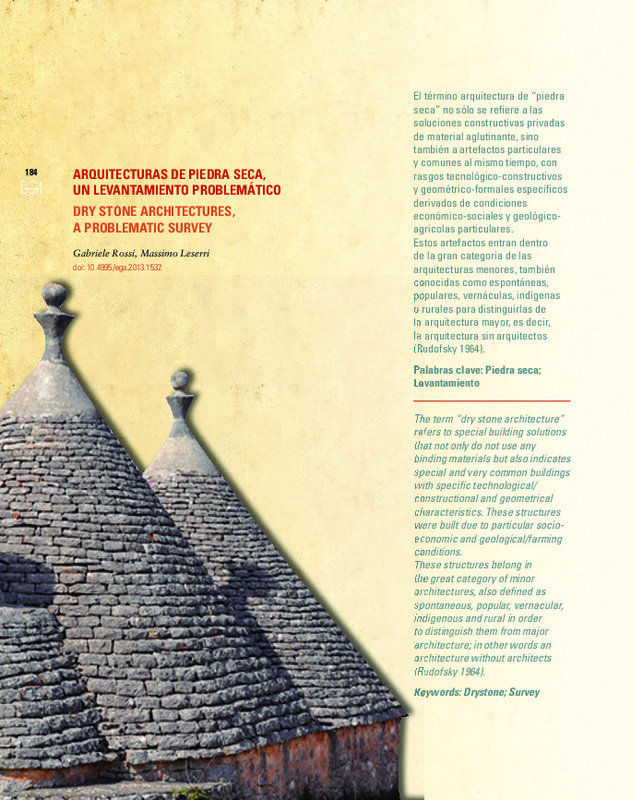JavaScript is disabled for your browser. Some features of this site may not work without it.
Buscar en RiuNet
Listar
Mi cuenta
Estadísticas
Ayuda RiuNet
Admin. UPV
Arquitecturas de piedra seca, un levantamiento problemático
Mostrar el registro sencillo del ítem
Ficheros en el ítem
| dc.contributor.author | Rossi, Gabriele
|
es_ES |
| dc.contributor.author | Leserri, Massimo
|
es_ES |
| dc.date.accessioned | 2016-12-23T09:21:36Z | |
| dc.date.available | 2016-12-23T09:21:36Z | |
| dc.date.issued | 2013-11-06 | |
| dc.identifier.issn | 1133-6137 | |
| dc.identifier.uri | http://hdl.handle.net/10251/75702 | |
| dc.description.abstract | [EN] The term “dry stone architecture” refers to special building solutions that not only do not use any binding materials but also indicates special and very common buildings with specific technological/constructional and geometrical characteristics. These structures were built due to particular socio-economic and geological/farming conditions.These structures belong in the great category of minor architectures, also defined as spontaneous, popular, vernacular, indigenous and rural in order to distinguish them from major architecture; in other words an architecture without architects (Rudofsky 1964 | es_ES |
| dc.description.abstract | [ES] El término de arquitectura de “piedra seca” no solo se refiere a las soluciones constructivas privadas de material aglutinante, sino también a artefactos particulares y comunes al mismo tiempo, con rasgos tecnológico-constructivos y geométrico-formales específicos derivados de condiciones económico-sociales y geológico-agrícolas particulares. Estos artefactos entran dentro de la gran categoría de las arquitecturas menores, también conocidas como espontáneas, populares, vernáculas, indígenas o rurales para distinguirlas de la arquitectura mayor, es decir, la arquitectura sin arquitectos (Rudofsky 1964). | es_ES |
| dc.language | Español | es_ES |
| dc.language | Inglés | es_ES |
| dc.publisher | Universitat Politècnica de València | |
| dc.relation.ispartof | EGA. Revista de Expresión Gráfica Arquitectónica | |
| dc.rights | Reserva de todos los derechos | es_ES |
| dc.subject | Piedra seca | es_ES |
| dc.subject | Levantamiento | es_ES |
| dc.subject | Drystone | es_ES |
| dc.title | Arquitecturas de piedra seca, un levantamiento problemático | es_ES |
| dc.title.alternative | DRY STONE ARCHITECTURES, A PROBLEMATIC SURVEY | es_ES |
| dc.type | Artículo | es_ES |
| dc.date.updated | 2016-12-23T08:41:21Z | |
| dc.identifier.doi | 10.4995/ega.2013.1532 | |
| dc.rights.accessRights | Abierto | es_ES |
| dc.description.bibliographicCitation | Rossi, G.; Leserri, M. (2013). Arquitecturas de piedra seca, un levantamiento problemático. EGA. Revista de Expresión Gráfica Arquitectónica. 18(22):184-195. https://doi.org/10.4995/ega.2013.1532 | es_ES |
| dc.description.accrualMethod | SWORD | es_ES |
| dc.relation.publisherversion | https://doi.org/10.4995/ega.2013.1532 | es_ES |
| dc.description.upvformatpinicio | 184 | es_ES |
| dc.description.upvformatpfin | 195 | es_ES |
| dc.type.version | info:eu-repo/semantics/publishedVersion | es_ES |
| dc.description.volume | 18 | |
| dc.description.issue | 22 | |
| dc.identifier.eissn | 2254-6103 | |
| dc.description.references | – DIMITRI A., 2002, Trulli e muri a secco tra Manduria, Maruggio e Torricella, Provveduto Editore, Manduria. | es_ES |
| dc.description.references | – NEGLIA G., 1970, Il fenomeno delle cinte di "Specchie" nella penisola salentina, Adriatica Editrice, Bari. | es_ES |
| dc.description.references | – ROHLFS G., 1963, Primitive costruzioni a cupola in Europa, Leo S. Olschki Editore, Firenze. | es_ES |








